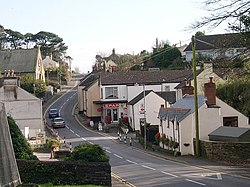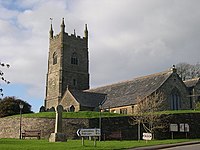Pelynt
| Pelynt Cornish: Pluwnennys | |
| Cornwall | |
|---|---|
 Pelynt | |
| Location | |
| Grid reference: | SX203550 |
| Location: | 50°22’5"N, 4°31’40"W |
| Data | |
| Local Government | |
| Council: | Cornwall |
Pelynt is a village in Cornwall four miles west-northwest of Looe. It had a recorded population of 1,296 at the 2011 census.
History
The name Pelynt derives from Cornish pluw (parish) and the name of St Non, the mother of St David.[1]
The manor of Pelynt is mentioned in the Domesday Book (1086) when it was valued much higher than Looe; it was held by Algar from Robert, Count of Mortain. There was half a hide of land and land for 8 ploughs. There were three and a half ploughs, 6 serfs, 4 villeins, 12 smallholders, 30 acres of woodland, 40 acres of pasture, 2 cattle, 14 pigs and 37 sheep. The value of the manor was £1 sterling though it had formerly been worth £2-10s.[2]
Parish church

The parish church is dedicated to St Nonna and built in the Perpendicular Gothic style. In about 1680, one of the arcades was remodelled in Tuscan Doric style. The tower is of the 14th century, earlier than the rest of the church.
There are a number of interesting memorials including a number to the local Trelawny family.[3] One is a memorial to Bishop Jonathan Trelawny, who is buried her and whose pastoral staff is preserved in the church. Bishop Trelawny was one of the Seven Bishops arrested by King James II for petitioning the King against the Declaration of Indulgence in 1688, an incident contributory to King James being deposed a few months later.
About the village

The village has a school, founded in 1882, and a 16th-century inn, The Jubilee.
There is an ancient barrow cemetery nearby: ten barrows still exist and others have been destroyed.[3] The Rillaton Cup and the Pelynt Dagger are two artefacts that have been found in Cornwall that show contact with the Mycenaean Greek world.[4][5]
The first mention of a post office in Pelynt was in May 1852, when a type of postmark known as an undated circle was issued. Details of some of the people who have run the post office, including William Churchill (1856), Harriet Andrews (1910) and Samuel Harvey (from 1929) appeared in a book published in 1988.[6]
Outside links
| ("Wikimedia Commons" has material about Pelynt) |
References
- ↑ Dowling, Jeremy. Church Trails in Cornwall. The Looe Area. The North Cornwall Heritage Coast & Countryside Service and the Diocese of Truro. ISBN 9781900046053.
- ↑ Thorn, C. et al., ed. (1979) Cornwall. Chichester: Phillimore; entry 5,15,3
- ↑ 3.0 3.1 Nikolaus Pevsner: The Buildings of England: Cornwall, 1951; 1970 Penguin Books ISBN 978-0-300-09589-0
- ↑ Christie, P. M. "Cornwall in the Bronze Age" in: Cornish Archaeology; 25
- ↑ The Ancient Greeks: An Introduction, Stephanie Lynn Budin, Oxford University Press
- ↑ Allen, Natalie (1988) Through the Letter-box, pp. 109-116, Liskeard, Cornwall: The Breton Press, ISBN 0-9508408-2-3
